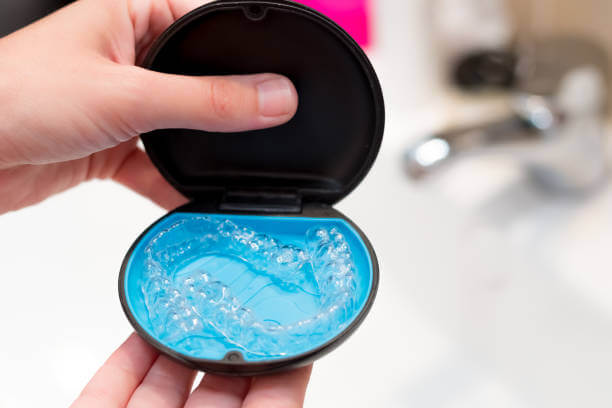Forget the days of traditional metal braces that invited tooth decay and trapped food particles. Invisalign is the popular alternative, offering a seamless journey to a perfect smile. If you are a good candidate for Invisalign braces, it is important to understand how Invisalign uses attachments to help you achieve the beautiful smile you desire.

To address complex tooth movements like rotation or vertical alignment, dentists often use Invisalign attachments. These small, tooth-colored bumps made from composite resin that stick onto individual teeth are designed to apply precise pressure to move teeth. They are attached to the tooth surface with a strong bonding agent and placed at precise locations to facilitate efficient and accurate movement. These attachments play an important role in your treatment plan and help guide your teeth to their ideal positions.
Before starting Treatment with Invisalign, you should Know About Invisalign Attachments that:
Getting attachments for your teeth is a simple process. Your dental professional will choose the appropriate type of attachment based on your specific dental needs and place them using a composite dental bonding material. Attachments come in different shapes like circular, square, rectangular, or triangular, and each shape is selected based on the specific movement required, for example, tooth rotation or assisting with vertical movements. Once the bonding agent is applied, the attachment material is set in place and hardened with a special curing light.
Here are some of the benefits of Invisalign with attachments:

Taking care of your Invisalign attachments is easy. Gently brush them with a soft-bristled toothbrush, and make sure to floss regularly to prevent food particles from building up. An electric toothbrush can be a helpful tool to use as well. Remember, giving your attachments a little extra attention will help keep your alignment procedure on track.
Attachments can significantly influence treatment time and effectiveness. For some patients, including those with severe malocclusions, attachments can mean shorter months of treatment by facilitating adequate tooth movements that aligners alone might not achieve. However, every patient’s treatment period will vary based on their individual orthodontic condition.
Whether Invisalign attachments are noticeable or not depends on their placement and color. These attachments are designed to match your natural tooth color and be discreet, but they may be more visible if located on the front teeth. While they aim to be inconspicuous, complete invisibility cannot be guaranteed, especially up close. However, the visual impact is generally considered minor and temporary when compared to the benefits of achieving a straighter smile.
The process of installing Invisalign attachments is usually not painful. However, you may feel some discomfort when the aligners are initially put on since they may feel tighter with attachments. This sensation occurs because the aligners fit more snugly around the teeth with attachments, which is necessary for effective treatment. If an attachment causes any discomfort inside your mouth, you can apply a ball of orthodontic wax over the area to prevent irritation, and or take an over the counter pain reliever.
It’s possible for Invisalign attachments to fall off, but it’s not a frequent occurrence. This can happen due to poor bonding or heavy forces from biting or chewing. Although it’s not an immediate cause for concern, it’s important not to ignore it. The attachments act as anchors and are crucial in guiding your teeth into the desired positions. Therefore, if you experience an attachment falling off, it’s essential to contact your orthodontist or dentist as soon as possible. They will reapply the attachment and continue your treatment as planned.
Invisalign attachments are not universally necessary for every Invisalign patient; rather, they serve a specific purpose to enhance the treatment’s effectiveness. Depending on the dental issue, attachments can be crucial when more complex tooth movements are needed, acting as anchors that provide a firmer grip for the aligners on the teeth
Many orthodontic patients worry about whether attachments may damage their teeth. However, that is not the case with Invisalign attachments. These attachments are made of a safe dental resin material, which is similar to what’s used for dental fillings. In case you’re wondering whether you can eat normally with attachments, the answer is yes, but you should avoid excessively hard or dark foods that could wear down or stain the attachments. Finally, always inform your dentist if any attachments feel loose.

Invisalign is a modern alternative to traditional braces that has revolutionized orthodontic treatment. Attachments are a key component of this innovative system, helping to create healthy, attractive, and long-lasting smiles. These attachments are particularly useful in producing effective tooth movements, making them an invaluable addition to a personalized treatment plan.
If you’re dealing with crowded teeth, gaps, or complex tooth movements in the Fairview Allen area, and would like to take the next step in achieving a picture-perfect smile, contact Sloan Creek Dental to schedule a consultation online or call 972-468-1440
At Sloan Creek Dental, we are dedicated to helping you create a customized Invisalign experience that is tailored to your specific needs and goals. Remember, straight teeth not only improve your appearance, but also contribute to your overall health and well-being.
Our dental office is located in Fairview, Texas, and our patients visit us from across the surrounding areas, including Allen, Plano, McKinney, and Lucas.
We firmly believe that the internet should be available and accessible to anyone, and are committed to providing a website that is accessible to the widest possible audience, regardless of circumstance and ability.
To fulfill this, we aim to adhere as strictly as possible to the World Wide Web Consortium’s (W3C) Web Content Accessibility Guidelines 2.1 (WCAG 2.1) at the AA level. These guidelines explain how to make web content accessible to people with a wide array of disabilities. Complying with those guidelines helps us ensure that the website is accessible to all people: blind people, people with motor impairments, visual impairment, cognitive disabilities, and more.
This website utilizes various technologies that are meant to make it as accessible as possible at all times. We utilize an accessibility interface that allows persons with specific disabilities to adjust the website’s UI (user interface) and design it to their personal needs.
Additionally, the website utilizes an AI-based application that runs in the background and optimizes its accessibility level constantly. This application remediates the website’s HTML, adapts Its functionality and behavior for screen-readers used by the blind users, and for keyboard functions used by individuals with motor impairments.
If you’ve found a malfunction or have ideas for improvement, we’ll be happy to hear from you. You can reach out to the website’s operators by using the following email
Our website implements the ARIA attributes (Accessible Rich Internet Applications) technique, alongside various different behavioral changes, to ensure blind users visiting with screen-readers are able to read, comprehend, and enjoy the website’s functions. As soon as a user with a screen-reader enters your site, they immediately receive a prompt to enter the Screen-Reader Profile so they can browse and operate your site effectively. Here’s how our website covers some of the most important screen-reader requirements, alongside console screenshots of code examples:
Screen-reader optimization: we run a background process that learns the website’s components from top to bottom, to ensure ongoing compliance even when updating the website. In this process, we provide screen-readers with meaningful data using the ARIA set of attributes. For example, we provide accurate form labels; descriptions for actionable icons (social media icons, search icons, cart icons, etc.); validation guidance for form inputs; element roles such as buttons, menus, modal dialogues (popups), and others. Additionally, the background process scans all of the website’s images and provides an accurate and meaningful image-object-recognition-based description as an ALT (alternate text) tag for images that are not described. It will also extract texts that are embedded within the image, using an OCR (optical character recognition) technology. To turn on screen-reader adjustments at any time, users need only to press the Alt+1 keyboard combination. Screen-reader users also get automatic announcements to turn the Screen-reader mode on as soon as they enter the website.
These adjustments are compatible with all popular screen readers, including JAWS and NVDA.
Keyboard navigation optimization: The background process also adjusts the website’s HTML, and adds various behaviors using JavaScript code to make the website operable by the keyboard. This includes the ability to navigate the website using the Tab and Shift+Tab keys, operate dropdowns with the arrow keys, close them with Esc, trigger buttons and links using the Enter key, navigate between radio and checkbox elements using the arrow keys, and fill them in with the Spacebar or Enter key.Additionally, keyboard users will find quick-navigation and content-skip menus, available at any time by clicking Alt+1, or as the first elements of the site while navigating with the keyboard. The background process also handles triggered popups by moving the keyboard focus towards them as soon as they appear, and not allow the focus drift outside of it.
Users can also use shortcuts such as “M” (menus), “H” (headings), “F” (forms), “B” (buttons), and “G” (graphics) to jump to specific elements.
We aim to support the widest array of browsers and assistive technologies as possible, so our users can choose the best fitting tools for them, with as few limitations as possible. Therefore, we have worked very hard to be able to support all major systems that comprise over 95% of the user market share including Google Chrome, Mozilla Firefox, Apple Safari, Opera and Microsoft Edge, JAWS and NVDA (screen readers), both for Windows and for MAC users.
Despite our very best efforts to allow anybody to adjust the website to their needs, there may still be pages or sections that are not fully accessible, are in the process of becoming accessible, or are lacking an adequate technological solution to make them accessible. Still, we are continually improving our accessibility, adding, updating and improving its options and features, and developing and adopting new technologies. All this is meant to reach the optimal level of accessibility, following technological advancements. For any assistance, please reach out to